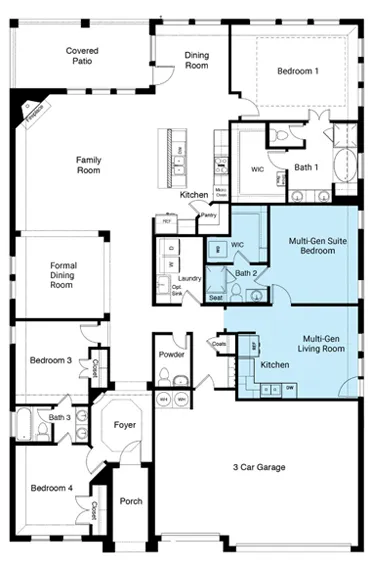Multigenerational living is making a comeback in America, and the real estate industry is taking notice. The living arrangement had long declined in the U.S., reaching a low point in the 1970s. Since then, multigenerational living has steadily risen. The share of the U.S. population in multigenerational homes more than doubled between 1971 and 2021. Now, about one in five Americans lives in a multigenerational home.
As housing costs have risen, more families are pooling resources to afford buying a home or making rent payments in expensive markets. Adult children who live with their parents may be burdened with student loans and unable to afford living alone. Older Americans moving in with their kids is also becoming more common. Assisted living and senior housing have lost some luster since the pandemic, and more elderly Americans are less financially secure and able to live alone. America’s growing immigrant population is also contributing to the trend. Asian and Hispanic populations are growing steadily, and these ethnic groups are more likely than whites to live in multigenerational households.
Multigenerational living presents challenges, such as clashing lifestyle preferences and lack of privacy. However, numerous surveys show that Americans are warming to the idea. With childcare costs rising, multigenerational arrangements offer in-home help. Pooling financial resources also goes beyond paying the rent or mortgage. It leads to shared grocery bills, transportation, home maintenance, and repair. There are also emotional benefits. While younger adults may yearn for more independence, older Americans may enjoy being closer to family and not living alone. Research shows the adverse effects of loneliness and social isolation on seniors, which multigenerational living helps ease.
The Census Bureau classifies a multigenerational home as three or more generations living under one roof. Growth accelerated during the financial crisis between 2007 and 2009 and revved up again during the pandemic. The Pew Research Center suggests the trend will keep growing. Amid this cultural change, the real estate market is starting to adapt. Since the post-World War II suburban housing boom, communities have been designed primarily for the nuclear family. This is still true for many single-family homes. In apartment properties, even the nuclear family might not be on developers’ minds. Many multifamily properties in major U.S. markets are designed for young professionals and singles. “If you go to most of these apartments, I can bet you they have more accommodations for pets than a young family with a toddler,” said Bobby Fijan, a real estate developer and PropTech co-founder based in Dallas. If a young couple decides to have children while living in an apartment, they almost always consider moving out and finding a bigger space. Similarly, if an ailing grandparent must move in, a family may not have the space to accommodate them.
The housing market is slow to react to new trends, so accommodations for multigenerational living are less prominent now. Smaller apartments and homes also get higher rents per square foot, so most markets have similar layouts. Developers try to maximize their NOI, building the product that will sell the fastest. “Developers with longer-term capital can think of trends like this and what comes next,” said Fijan. By building something different, developers gain an advantage of a growing demand for multigenerational living.

Some housing developers have started down this path. Ashton Woods lists multigenerational homes as a specialty and has designed one of its Phoenix offerings, The Claridge Plan, specifically for them. The homes have customizations like an optional kitchenette and additional rooms. Homebuilder D.R. Horton is also leaning into the trend, marketing its multigenerational homes with the tagline, “Two homes under one roof.”
Multigenerational housing designs come in different forms. They may include two master suites, a mother-in-law suite built like a small apartment, a detached accessory dwelling unit, or a private dwelling attached to the main home. First-floor bedrooms with their own showers are often essential for seniors with mobility issues. Additional rooms give people more space and privacy. Having a space where everyone can gather for family activities is also important. Homeowners can renovate existing homes, adding interconnecting doors and expanding to include attached secondary suites. Multigenerational housing usually requires more expensive spaces, a plus for real estate owners.
Zoning regulations are among the most significant barriers to increasing housing supply suited for multiple generations. Local building codes and zoning laws regulate in-law suites and other accessory dwelling units (ADUs). A long-time preference for single-family zoning prevails throughout much of the U.S. Density zoning and more liberal rules for ADUs are gaining traction because of ‘missing middle’ housing, the housing between single-family homes and high-rise apartments. Zoning ordinances in many communities make building duplexes and triplexes difficult or even illegal. Adding this type of housing can also face pushback from NIMBYs. Accessory dwelling units remain a fraction of the country’s housing supply, but as more ordinances are adopted that ease restrictions, millions more are coming online in the next decade.
Research shows that more than half of all ADUs are concentrated in just four states: California (30 percent), Florida (12 percent), Texas (10 percent), and Georgia (5 percent). Statewide legislation for these units in California is deemed a nationwide model, enabling property owners to build a second unit without the restrictions common across the U.S. As a result, ADU construction has soared in California, with 20 percent of all building permits issued in the state in 2022 for this type of housing. California also has the nation’s second-highest percentage of multigenerational homes. High living costs, large immigrant populations, and housing shortages explain why. Easing restrictions on accessory dwelling units will not solve every problem, but it can help reduce the housing crisis and encourage multigenerational living.
The multifamily industry can adapt to the trend by offering larger spaces. Studio and one-bedroom apartments saturate apartment inventory in most U.S. markets, which don’t provide enough space for larger families. Multifamily properties that offer more bedrooms, larger floorplans, and multiple bathrooms could solve this problem. They could also stand out in a crowded market of apartments that primarily serve younger renters. Some multifamily products like this exist, but they are rare. Government policies and programs could also encourage multigenerational living more, as they do in other countries. In Singapore, the Kampung Admiralty is a massive living space that opened in 2018 that meets the needs of seniors and integrates them into a vision of intergenerational living. A childcare center is next to eldercare facilities, a medical center, a bank, and a supermarket.
The rise of multigenerational living isn’t expected to slow. The economic and cultural factors driving the trend will likely only exacerbate. The stigma of multigenerational living is also fading. A living arrangement that’s more common in foreign countries is becoming more typical in America. The real estate industry has reacted slowly, but progress is being made, and developers who lean into the trend may capitalize on a growing demand. Zoning restrictions are a barrier to multigenerational living arrangements in some jurisdictions but are also slowly changing. With more American families living under the same roof, the implications for residential real estate may only get bigger.









